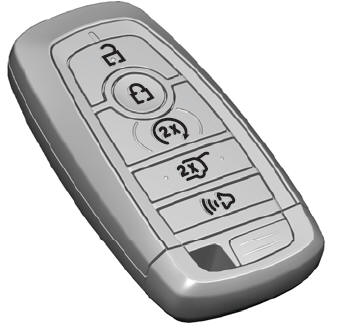Lincoln Aviator 2020-2025 Service Manual / Electrical / Electronic Feature Group / Cruise Control / Removal and Installation - Cruise Control Module (CCM)
Lincoln Aviator: Cruise Control / Removal and Installation - Cruise Control Module (CCM)
Removal
NOTE: Removal steps in this procedure may contain installation details.
All vehicles
-
NOTE: If installing a new CCM, it is necessary to upload the module configuration information to the scan tool prior to removing the module. This information must be downloaded into the new CCM after installation.
Using a diagnostic scan tool, begin the PMI process for the CCM following the on-screen instructions.
-
Remove the front bumper cover.
Refer to: Front Bumper Cover (501-19 Bumpers, Removal and Installation).
Cruise control module (CCM)
-
Disconnect the CCM electrical connector.
.jpg) |
-
Separate the grommets from the CCM bracket studs and remove the CCM.
.jpg) |
-
Inspect the grommets for damage. Replace the CCM if necessary.
.jpg) |
Cruise control module (CCM) bracket
-
Disconnect the CCM electrical connector.
.jpg) |
-
Separate the grommets and remove the CCM.
.jpg) |
-
Remove the CCM bracket screws and the CCM bracket.
Torque: 44 lb.in (5 Nm)
.jpg) |
Installation
-
To install, reverse the removal procedure.
-
NOTE: This step is only necessary when installing a new component.
Using a diagnostic scan tool, complete the PMI process for the CCM following the on-screen instructions.
-
Align the CCM.
Refer to: Cruise Control Radar Alignment (419-03B Cruise Control, General Procedures).
 General Procedures - Cruise Control Radar Alignment
General Procedures - Cruise Control Radar Alignment
Activation
Vertical Alignment
NOTE:
In order to align the CCM,
the front bumper cover must be removed to access the sensor and the
vehicle must be in a wheel alignment bay station so that the vehicle is
level...
Other information:
Lincoln Aviator 2020-2025 Service Manual: Removal and Installation - High Voltage High Current Fuse - Plug-In Hybrid Electric Vehicle (PHEV)
Removal WARNING: To prevent the risk of high-voltage shock, always follow precisely all warnings and service instructions, including instructions to depower the system. The high-voltage system utilizes approximately 450 volts DC, provided through high-voltage cables to its components and modules...
Lincoln Aviator 2020-2025 Service Manual: Removal and Installation - Brake Disc Shield
Removal NOTE: Removal steps in this procedure may contain installation details. Remove the brake disc. Refer to: Brake Disc (206-03 Front Disc Brake, Removal and Installation). Remove the 3 bolts and the brake disc shield...
Categories
- Manuals Home
- Lincoln Aviator Owners Manual
- Lincoln Aviator Service Manual
- Body and Paint
- Locking and Unlocking
- Keyless Entry
- New on site
- Most important about car
Remote Control
Passive Key

The passive key operates the power locks and the remote start system. The passive key must be in your vehicle to use the push button start.
Note: You may not be able to shift out of park (P) unless the passive key is inside your vehicle.
Copyright © 2025 www.liaviator2.com

